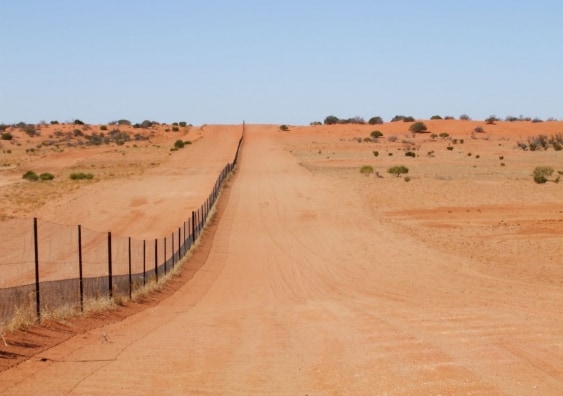Australia’s Dingo Fence is visible from space. Now researchers say the dingo’s role in protecting desert biodiversity is too.
Stretching some 5,600 kilometers across the Strzelecki Desert in Australia is the Dingo Fence, a structure built in the late 19th century in order to protect livestock from the wild dogs in Queensland, New South Wales and South Australia. It’s visible from space, and now researchers say the role the dingo plays in protecting biodiversity is visible from space too.
Their work, newly published in the journal Landscape Ecology, is based in part on 32 years’ worth of satellite imagery that illustrates the differences in desert plants growing in the red sands divided by the dingo barrier.
It seems counterintuitive, especially in the context of Australia’s long-running battles over the predator, but the researchers from University of New South Wales Centre for Ecosystem Science say the dingo presence benefits the shrubs and dry grasses precisely because of that predator status.
“Dingoes indirectly affect vegetation by controlling numbers of kangaroos and small mammals,” said Dr. Mike Letnic, senior author of the study. “When dingoes are removed, kangaroo numbers increase, which can lead to overgrazing. This has follow-on effects to the entire ecosystem.”
The NASA and United States Geological Survey’s Landsat images have been taken continuously since 1988 and make it possible to compare the differences in plant life, alongside the scientists’ own field work. That data access is especially important because Australia began fencing off the dingoes more than a century ago, and – as in other places in the world – scientists have lacked visibility into the impacts over long stretches of time.
Lead author Dr. Adrian Fisher, a remote sensing specialist at UNSW, said how the vegetation responds to rain is a key difference between the areas with and without the dingoes.
“While rainfall caused vegetation to grow on both sides of the fence, we found that vegetation in areas without dingoes didn’t grow as much – or cover as much land – as areas outside the fence,” said Fisher. Researchers also have found that removing the dingoes could change the flow of wind and sand because of vegetation changes, or damage soil quality as kangaroo population feed, or even threaten some species that rely on the plants – thus altering the desert landscape itself.
These “domino effect” impacts are known as trophic cascade.
“The removal of apex predators can have far-reaching effects on ecosystems that manifest across very large areas,” Letnic explained. “The Australian dingo fence – which is a sharp divide between dingo and non-dingo areas – is a rare opportunity to observe the indirect role of an apex predator.”
The scientists also fenced off small plots and found that after five years, the kangaroo-free plots in the dingo-free zones looked like islands of grass. While there are other contributing factors within the ecosystem, Fisher said it is clear the dingoes play a key role.
It’s also clear that harnessing the power of technology will advance the environmental science.
“Our study is an example of how satellite technology can be used in big picture environmental research,” he adds. “With over three decades’ worth of data, this technology has opened up so many research possibilities.”
This story first appeared on Sustainability Times
South Africa Today
© 2021 Sustainability Times.
This article is licensed under a Creative Commons Attribution-ShareAlike 4.0 SA International License.












